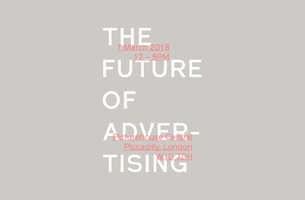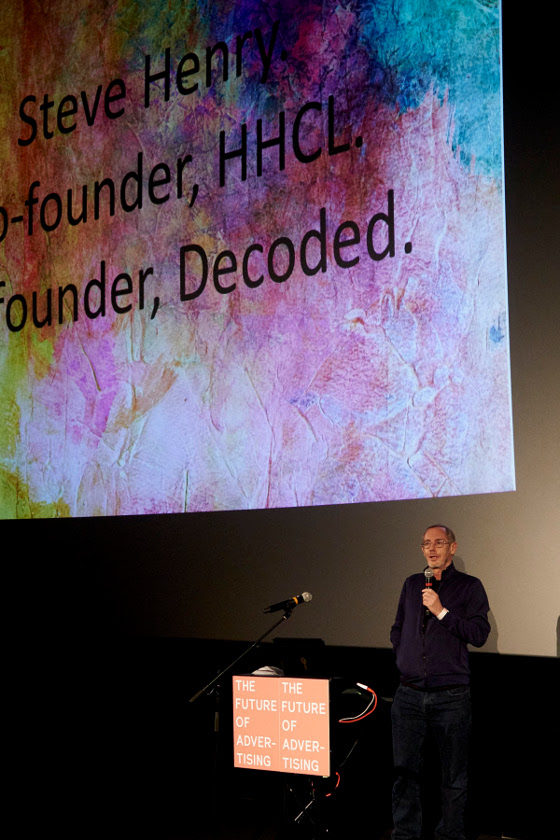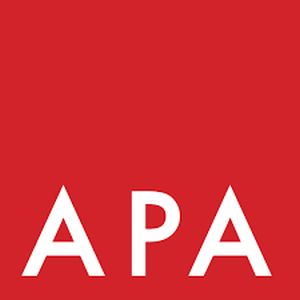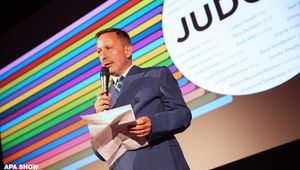
The APA’s Future of Advertising… In One Report

On Wednesday, March 7th London’s Picturehouse Central found itself stuffed to the rafters with creative and production talent for the Advertising Producers Association’s annual ‘Future of Advertising… in One Afternoon’ thought leadership event. This years was a particularly varied line-up of speakers from a broad range of disciplines, from advertising creatives to consultants, artists and experts in culture. Here’s a summary of the thoughts flying around the room.
Just a few days after releasing their first campaign - a heavy-metal ripper for alternative energy brand OVO - Natalie Graeme and Nils Leonard from Uncommon Creative Studio appeared in front of an industry audience waiting with bated breath to hear from London’s most intriguing new agency. The main crux of their discussion was a thread that ran through most of the day’s talks: if you’re having good ideas that you believe in, why would you give up on them just because the client won’t buy them? As Natalie and Nils suggested would be part of their creative studio’s model moving forward, if clients don’t buy their best ideas then they’ll find someone else to invest in them, whether that’s as brand campaigns or start-up businesses.
The pair spoke more about Uncommon’s self-reliant ethos - an environment where employees are encouraged to develop their ideas into business ventures in their own right. They noted that the really grea talent leaving the creative industries is seeping out to self-generated startups, not the Googles and Facebooks of the world.

Uncommon's Natalie Graeme and Nils Leonard
Nils also expressed excitement about the potential to build new brands completely from Scratch, although Natalie wouldn’t allow him to say too much about what they have in the pipeline. We’ll all be waiting with bated breath.
Next up was Contagious’s Katrina Dodd, who spoke on a theme that’s rearing its head in the advertising sphere quite regularly these days. She focused on the concept of masculinity and how brands should be approaching it, after decades of getting it wrong.
One emblematic campaign on the subject is AXE’s dramatic shift to a new definition of masculinity with their ‘Find Your Magic’ campaign two years ago. Then she went on to talk through some of the most interesting projects where brands and masculinity have intersected, from KFC South Africa’s ‘Everyman Meal’ radio ads to Covergirl’s decision to use James Charles as its first male face of the make-up brand.
Speaking of make-up, Katrina’s presentation ended on an idea for any brand who wants to engage with these kinds of issues. Sleek MakeUp’s response to a culture of make-up shaming led to a manifesto.
The Sleek MakeUp Manifesto:
- We will be truly representative of all makeup junkies, especially those often ignored in the beauty industry
- We will stand up to makeup shaming and support our consumers in their passion for makeup
- We will continue to showcase our consumers and their amazing looks and skills in our campaigns, in the way they want to be seen
- We will be brave and bold in challenging beauty industry norms
This could be adapted to fit any brand and any cause, she argued. If brands want a mission, it’s never been easier to find one.
Chief marketing officer at IAB James Chandler took to the stage next with a data-packed presentation about digital marketing. The key takeaways were the importance of telling the difference between genuine growth and a fad and learning how to produce work for the format it will end up on. Cutdowns of TV ads are not good enough for social content and ultimately end up being a wasted media opportunity.
James’ talk was structured around four key tenets that will serve you well as we move into an ever more digital future:
1. Numbers can be deceiving
2. It’s OK if you don’t get it right first time
3. Storytelling won’t change, spaces will
4. Beware the shiny and new
Jillian Gibbs, founder and CEO of Advertising Production Resources, had a very practical set of slides for the mostly production-oriented audience in the room at the Picturehouse - a masterclass in how production companies can best work direct to client, and how to interact with brands’ procurement departments. In a landscape where agencies and post companies are producing films, edit houses are offering grading services and media agencies are creating content, of course more and more production companies are considering ways to work direct to client. Jillian clearly laid out what companies need to know and what actions they need to take to fit into this new model.
As Steve pointed out, the presentation from artist Mr Bingo largely fell into the ‘engaging, but not especially relevant’ category. He admitted early on in his talk that while he used to do advertising, he didn’t really enjoy it and decided to pack it all in a number of years ago. Nevertheless, his high-energy multimedia autobiography kept the audience engaged through to the mid-afternoon break and his overall message quite neatly tied in with the Uncommon philosophy that had kicked off the day - if you believe in something, don’t ask for someone else’s permission to do it. Just do it and figure out how to make money from it later on. If Bingo or Natalie and Nils are to be believed, there are people out there who will pay for great (or intensely silly) ideas.

Mr Bingo
The second half of the APA’s programme kicked off with the IDEAS awards (the Interactive, Digital, Experiential Advertising Showcase), celebrating the best non-traditional work made by APA members.
Here are the winners:
Best Augmented Reality Experience via Mobile Device (Phone/Tablet)
Best Branded Experience Using Augmented, Virtual or Mixed Reality via Headset/Wearable
Best Use of 360° Video
Best Music/Sound Design in An Interactive Experience
Best Experiential Campaign/Branded Installation
THE BIG IDEA
Thomas Thomas & Grey London | The Wayback Project
Next on stage was Leila Fataar, founder of multidisciplinary company Platform 13, whose 20 years in the industry has been focused on creating cultural value for brands. As she well knows, every agency, director and producer in the industry wants to be creating relevant culture, But the success stories are few and far between compared to the level of output. And the campaigns that get it wrong (Pepsi?) earn their own special place in the memory of the consumer.
Culture requires constant monitoring and evaluation as it adapts and changes, and the complexities of marketing will only increase as technology advances. “From now to 2020, we will see the biggest political, societal, cultural and technological transformation since the industrial revolution,” said Leila. The youth of today are born ‘woke’, informed, curious and self-educating, with a heightened awareness of inequality and politics. They’re coming of age faster than any generation before them and they’re cynical of big brands, global media and the establishment, she said. They’ll search out the authentic, pursuing personal progression and communal creativity on one side, whilst subverting reality and tearing down social constructs.
Genuine collaboration is the way Leila believes brands can be part of this. She’s fighting the tendency to call anyone with 1,000 subscribers on YouTube an ‘influencer.’ She emphatically stated that those aren’t influencers. There are plenty of young, entrepreneurial people fully immersed in their own passions, gaining commercial success from it away from that world. WAH’s Sharmadean Reid, Boiler Room’s Blaise Bellville, KuruptFM - the talent Leila works with at Platform13 and connects with brands.
We all know people respond best to authentic work. It resonates and builds much stronger relationships between brands and consumers. So why are brands working with agencies with creative teams disproportionately NOT representative of the average consumer, and then being disappointed when new work drops and immediately fizzles out? With 69% of people distrusting advertising, the moment for collaboration has never been more pertinent. Let’s be more aware of the consequences of what we do and the ridiculously privileged position we’re in to be creating work that affects change, argued Leila. If we do it right, the commercial rewards are just the tip of what we have to gain.
Liam Walsh, creative technology director at Nexus Studios joined us next to help cut through the hype and understand the benefits of using the latest in AR technology. AR has been around for over 20 years, but we’ve only recently reached a stage where technology, and the creative ambition of the artists behind these projects, is beginning to produce truly groundbreaking work.
As we enter the second wave of AR, we can see a more immersive, integrated and interactive experience available to users. So what’s next? Like cinema before it, it’ll need to shift from the technology alone impressing audiences towards creating experiences and stories that evoke wonder. Now we’re past the gimmicky stage, it’s a critical time to be exploring the capacity for storytelling, before interest plateaus.
AR is about augmenting the human experience and it will not advance in isolation, stressed Liam. The real impact will be when it becomes a super medium that combines other parallel emerging technologies like wearable computing, sensors, machine learning and AI.
Steve Henry rounded off the afternoon speaking about the highs and lows of his advertising career and how it led him to found Decoded in 2011. Known for his way with words; “You know when you’ve been Tango’d” and “does exactly what it says on the tin” to name a few, Henry helped create some of the best ads of the ‘90s and ‘00s. As part of the team that founded HHCL (Campaign’s Agency of the Decade in 2000) he just wanted to run a creative team that could be their own boss. “We didn’t want to do lager ads that were just misogyny masquerading as laddish humour,” he said.

Steve Henry
He recalled how initially they were completely ostracised by the rest of the industry and it was only after a few award-winning campaigns and a Cannes Grand Prix that mood began to change. Their approach was living proof that playing it safe would never make you a success. The isolation taught HHCL how to fight, how to gain clients and keep them, and most importantly to Steve, to make work that they were creatively proud of.
He highlighted how self-defeating it is to go into a creative meeting with two safe ideas and the two ideas you actually want to do. Get rid of the safe ideas completely, he said. Don’t let the client ever see them. It’s a waste of money, time and talent.
The notion that there is a great idea that has nothing wrong with it is a myth, he said. Every great idea can be picked apart, but that doesn’t mean we shouldn’t believe in them.
Steve’s concluding mantra: “weird is good.” Humans love novelty, ignore the regular and familiar. If you want to sell an orange fizzy drink, paint a bald fat man orange and get him to slap a guy around the face. That’s weird. That’ll be remembered.











